|
Dutch
Barn Preservation Society
Dedicated
to the Study and Preservation
of New World Dutch Barns
NEWSLETTER
FALL 2003, Vol. 16, Issue 2
INFLUENCES
ON NEW YORK'S EARLY DUTCH ARCHITECTURE
Presentation by Shirley W Dunn; Conference on New
York State History, Bard College, June 6r 2003.
The purpose of this paper is to give a voice to an architectural
form which some readers may not know about. This form, one of the
very first farm buildings built by early Dutch settlers in present
New York, has disappeared, but it has had a striking influence.
We must set the scene: When you think of a Dutch-style house, you
have in mind steep-sloped Dutch roofs, originally developed to
support thatch or tiles in the Netherlands. With a few adjustments,
these proved practical in areas of Dutch settlement where heavy
snows were common, such as the Hudson Valley and Long Island. [Figure
1: Bronck House] An example is the Pieter Bronck House of Coxsackie,
probably built in 1663.
Figure #1. The stone house erected about 1663 by
Pieter Bronck at the present Coxsackie is now a museum supported
by the Greene County Historical Society. Photo by Robert Andersen.
The Bronck House seems to be the oldest nearly intact house in
the Dutch style remaining in New York State. It undoubtedly survived
because it was built of stone, rather than wood. My guess is the
stone was chosen for safety, in consideration of Peter Stuyvesant's
war against the Esopus Indians, a war being waged only a few miles
away near present-day Kingston. The Bronck House is wider than
deep, which makes it doubly special. The original front door was
in front, in the location of the present right front window, shown
in the picture. As evidence of the doorway, besides obvious changes
in the brickwork, there is the trap door to the cellar, with a
stair below it, which remains in the floor in front of where the
door was located, to the present time.
Special barns that we associate with Dutch framing styles also
were built in the seventeenth century - and some from the eighteenth
century, erected by Dutch descendents, still survive. They all
seem to have the same underlying framing pattern, which is surprising,
because barns in the Netherlands exhibited great variety. These
special "Dutch"
barns of the Hudson Valley and Long Island and New Jersey were
practical for storing and threshing wheat, at one time the major
crop of upstate New York. As a result, we often say that this barn
was a wheat barn, but it was used for other kinds of grain in the
Netherlands. [Figure 2: Van Bergen Dutch Barn] A photograph presents
the exterior of the ancient Marte Gerritsen Van Bergen barn in
Leeds. In 1928 it was still in good condition. This barn is believed
to be the one built by the year 1680, when it was mentioned in
a contract.(1) An interior view of the Van Bergen Barn [figure
3: interior framing] shows the anchor beam braces with lightly
curved soffits (undersides), typical of early Dutch construction.
The large horizontal anchor beams of this barn were about twenty
inches deep. On the saplings overhead hay and grain was stored.
The Van Bergen barn survived until a few decades ago, but by the
1970s its roof was off and after that the building tumbled down.
It is now gone, the site bull-dozed.

Figure #2. The Van Bergen Dutch
barn at present Leeds, New York, as it appeared in 1980. Photo
courtesy Dorothy Scanlon.
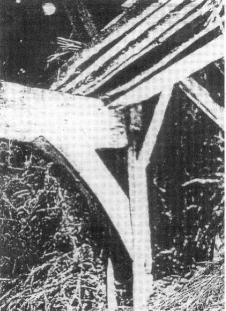
The interior of the Van Bergen barn of c. 1680
shows curved soffits on the anchorbeam braces.
Despite a popular impression, the steep-roofed houses and the
Dutch barns were not the only important forms established here
by the Dutch. To understand this perhaps surprising statement we
can go back to the beginning of Dutch farm settlement in the Hudson
Valley in the seventeenth century. Much of what we know about the
farms comes from the many letters of Kiliaen Van Rensselaer, a
Dutch merchant who established Rensselaerswyck in the area of present
Albany and Rensselaer counties.
The first upstate farm was established in 1631 by agents of Van
Rensselaer on fertile Castle Island, now the location of the Port
of Albany. There one large farmhouse was built in 1631 for Kiliaen
Van Rensselaer's first upstate farm family and a few farm helpers.
This farmhouse was described by Van Rensselaer as "a convenient
dwelling, the side and gable built up with brick, the dwelling
[as] long and wide as required."(2) He also wrote in a letter
about this building, "The house was furnished with all kinds
of implements and necessaries for the animals and the comfort and
support of the people and what further was needful."(3) Surprise!
The structure contained not only living quarters for the farm family
and the farm help but for animals in their stalls, as well as storage
and work areas, (More than thirty years later, this large frame
and brick farmhouse on Castle Island was washed away in the flood
of 1666.) Having the house and barn under one roof occasioned no
special comment in the 1600s because such buildings were common
in northern Europe and, in fact, are still erected, especially
in the Netherlands. Such a farmhouse, with its hay barracks and
even a nice Dutch wagon with outsize back wheels, was drawn on
a land survey in the Netherlands about 1600.(4) [Figure 4: survey]
A closer view of a Dutch barrack shows how a farmer stowed a similar
wagon in one.[Figure 5: Hay barrack]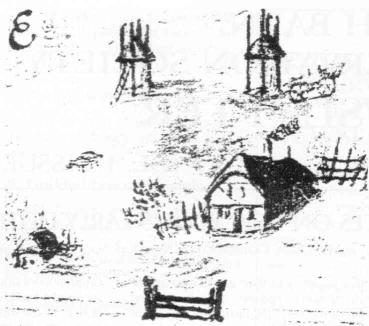
Figure #4. A Netherlands farmhouse with attached
barn, with its accompanying hay barracks and a wagon, was drawn
on a Dutch land survey about 1600. From Van vlechtwerk tot baksteen,
by J.J. Voskuil, Stichting Historisch Boerderij-Onderzoek, Arnhem,
1979. Used with permission.
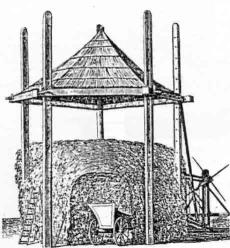
Figure #5. A Dutch hay barrack, also called a "Haystack."
From J. Ie Francq van Berkhey, Natuurlijke History van Holland,
VoI.IX, part 1 (Leiden, 1810).
Diagonally across the Hudson River from present Albany, the second
Van Rensselaer farm was established that same summer of 1631 near
a pine grove in an area called the Greenbush, meaning the pine
woods. The location is now within the City of Rensselaer. In 1631,
Roelof Jansen from the coast of Sweden became the first farmer
at the Greenbush farm. Roelof Jansen came to the area in 1630 after
a stop in the Netherlands. With him were his wife, and the now
famous Anneke Jans, and their three daughters. A son known as Jan
Roelofsen, was born after Roelof and Annetje arrived. Aiding Roelof
Jansen and his family with the farm work were two farm helpers,
Claes Claesen and Jacob Goyversen, both from Fleckero, Norway,
who came over in 1630 with Jansen.(5)
One large rectangular house for all these people and for their
livestock, grain storage, and work space was erected. It was, apparently,
similar to its mate built on Castle Island. The Greenbush farmer
began with four horses. Cows for his farm were detained down river,
but a few arrived the next year. Other buildings on the farm included
a Dutch-style hay barrack of four poles, fifty feet high, a barn
or shed, and a sheepcote.
This brand new Greenbush farmhouse accidentally burned in 1632,
but a replacement was built as quickly as possible. Fortunately,
Kiliaen Van Rensselaer, writing from the Netherlands, described
this new building: He said the people ". . . built again another
brick house, 80 feet long, the threshing floor 25 feet wide and
the beams 12 feet high, up to the ceiling."(6) The description
states that the replacement building was similar to the previous
one at Greenbush, and suggests it also was like the one built on
Castle Island across the river in 1631, which had the sides and
gable end built up with brick. The building was to be as long as
needed. As the Dutch foot was shorter than today's measure, the
actual length of the Greenbush building was about 72.5 feet and
the threshing floor just short of 23 feet across.
A few other farmhouses of this European type were erected in
the present Albany area within a few years. A small one burned
down on an east side farm south of Greenbush in 1640. Although
the farmer was not injured, the horses (mares, actually) in this
building were killed with the loss of their expected foals.(7)
On the other side of the river, archeological evidence of a building
over one hundred feet long, thought to be the one described in
a 1643 letter by Arent Van Curler, was unearthed about 1974 by
archeologist Paul Huey and others at the farm called the Flatts,
north of Albany. Van Curler's letter included valuable details
about arrangements: his farm hands were to sleep in an attic room
over the family's living quarters, while the foreman would have
his bunk in the barn section.(8)

Figure #6. Detail from the Manatus
Map of c. 1639 (copied in the 1660s), shows the two farms of
Wolfert Gerritsen in present Brooklyn. Harrisse collection, Maps,
Library of Congress.
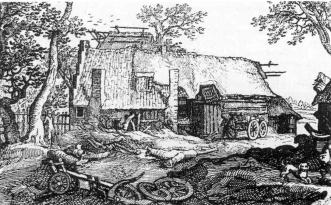
Figure #7. A seventeenth century barn in the Netherlands,
in the Gooi region, suggests the likely appearance of the farmhouses
built by Kiliaen Van Rensselaer at Creenbush and on Castle Island.
Detail from an engraving, "Tobias and the Angel," by
Abraham Bloemaert, 1620.
In addition, there are reports of similar buildings from the first
farms at Manhattan, where some of the men employed by Kiliaen Van
Rensselaer worked in 1630 before they came upriver. In particular,
Wolfert Gerritsen was in charge of assembling livestock at Manhattan
and shipping it up to the Fort Orange area for the new Van Rensselaer
farms. Two farms, each with a rectangular long farmhouse as well
as a hay barrack, were identified on a 1639 map of Manatus (Manhattan)
and environs as those of Wolfert Gerritsen. [Figure 6: Manatus
Map]
Fortunately, similar farmhouses were occasionally depicted in
the Netherlands. [Figure 7: Detail from Tobias and the Angel] A
Dutch artist, Abraham Bloemaert, in 1620 sketched a 'farmhouse
from the region called the Gooi or Gooiland.(9) The long building
fits the description of those planned for Greenbush and Castle
Island. Bloemaert has been criticized for making fun of the farms
by making them look run-down. Nevertheless, his picture is invaluable.
The stepped gable he showed was made of brick, as were the walls
and chimney of the living section on the left-hand side of the
picture. The resemblance to the farm houses built by Van Rensselaer's
orders is clear. Van Rensselaer had noted that the gable end of
his farmhouse on the Island was to be made of brick. In the picture,
the roof of the living part was covered with tiles, while the attached
barn section on the other end had wood siding, with a thatched
roof. Looming behind the living section was a hay barrack - this
one with a gable roof high in the air.
Clues to the interior arrangement of the farmhouse include the
front chimney serving the fireplace in the residence, which, in
the Dutch style, would not have a built-in oven. Rather, an extra
chimney at the center of the building served a separate oven for
baking. Documents suggest the farmhouse at Creenbush also had such
a special baking oven. In the early 1640s, Willem Juriaensz, a
baker, was paid for baking on the farm at Creenbush and for going
around to bake at Van Rensselaer's other farms. Willem Juriaensz
also visited and baked at the farm of Arent Van Curler, with its
long farmhouse on the Flatts, mentioned above.(10)
The reference to brick in construction changes common notions
of architectural history. Father Isaac Jogues had said of a visit
to Fort Orange in 1643 that the houses were "merely of boards
and thatched. As yet there is no mason work except the chimneys."(11)
His description is widely quoted as a snapshot of the wooden housing
of the period. However, Jogues, rescued from the Mohawks, was hiding
within Fort Orange. He did not notice that the large farmhouses
in the distance at Creenbush and Castle Island were constructed
in part with bricks. The bricks, sent by Kiliaen Van Rensselaer,
were probably the small yellow ones found on very early sites in
the Albany area.
Van Rensselaer, who contracted with Dutch farmers to go overseas
to the Hudson Valley to work on his farms, never let go of the
land, as we all understand, and he definitely pinched pennies.
Always concerned about costs in his overseas colony, Van Rensselaer
wanted an economical solution to housing his tenant farmers, their
families and their help, as well as the valuable farm animals.
These animals he supplied for the farm and from them he shared
the increase. It is not surprising that he selected a building
well-known to him to meet these requirements. Scholars have wondered
where this particular farmhouse type, built on Kiliaen van Rensselaer's
orders, might have originated?
A land speculator, Kiliaen van Rensselaer had invested in farmland
in the Gooi, the Dutch region of sandy soils where rye and oats
were cultivated. Interestingly, the poor soil there was not suitable
for wheat.
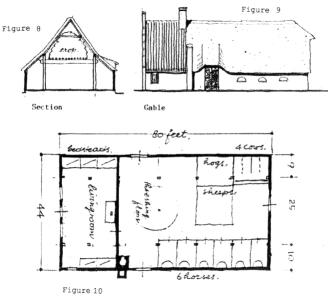 Figure
8- 10. Drawings by Jaap Schipper, a contemporary Netherlands
restoration architect, shows the appearance of a Gooi "Ionghouse" of
the seventeenth century. The interior layout includes a bakeoven
at the partition. Another sketch shows the framing, which Dutch
Barns followed for two centuries. The brick living section with
standing gable was roofed with tile, while the barn at rear was
thatched. Figure
8- 10. Drawings by Jaap Schipper, a contemporary Netherlands
restoration architect, shows the appearance of a Gooi "Ionghouse" of
the seventeenth century. The interior layout includes a bakeoven
at the partition. Another sketch shows the framing, which Dutch
Barns followed for two centuries. The brick living section with
standing gable was roofed with tile, while the barn at rear was
thatched.
This is the same region where Abraham Bloemaert sketched a typical
farmhouse, noted above. The special farmhouses built there combined
the tenant's home with stables, threshing floor, and overhead crop
storage under one roof. These rectangular Gooi farm buildings were
called longhouses. I believe these familiar and practical structures
of the Gooi were the ones Van Rensselaer copied in the Hudson Valley.
Such inclusive structures would be an efficient and economical
solution for new farms anywhere.
Restoration architect and historian Jaap Schipper of Amsterdam,
the Netherlands, prepared a few sketches for me of a farmhouse
of the Gooi type, [Figures 8, 9, 10: Schipper drawings]. The typical
Gooi farmhouses known to Schipper echo the early 1600s drawing
by Abraham Bloemaert amazingly well, both inside and out. The brick
living section with its parapet gable front was roofed with tile
while the barn at the rear was thatched. (Brick was practical and
fire-safe, but it also was used for show.) Schipper, moreover,
shows the interior plan. A bake oven is located at the partition,
just as it was in Bloemaert's sketch. However, in Schipper's drawing,
the main chimney happens to be at the back of the living section,
where there was a wall. The circle indicates the threshing floor.
The family home is at the left front, and boxes around the walls
depict built-in bedsteads. The workers probably slept above in
the loft room over the family dwelling.
One detail of Schipper's drawing shows a cross-section of the
framing of the barn. The crop was placed on saplings just as it
was in later Dutch barns in America, as you saw in the Van Bergen
barn. The anchorbeams were supported, not by the outside walls,
but by posts on each side of the threshing floor, also as it was
done in American Dutch barns. Note that a raised section of the
roof on the side accommodated the height of the wagon door. Most
importantly, outsi.de aisles for stalls flanked the threshing floor
on both sides. These aisles are specifically mentioned in early
Albany barn contracts. The roofs of some early barns, including
possibly the Van Bergen Bergen barn which you saw, may have had
a roof slope of two different pitches, with a "break" over
the aisles. The Bloemaert sketch hints at a curve or change in
the slope of the roof, but it may merely reflect the sagging of
the rafters.
NEWSLETTER
FALL 2003, Vol. 16, Issue 2, part two
|